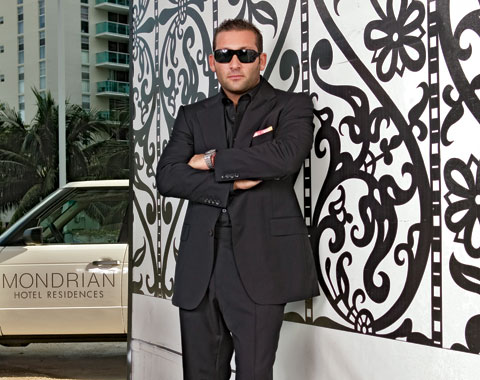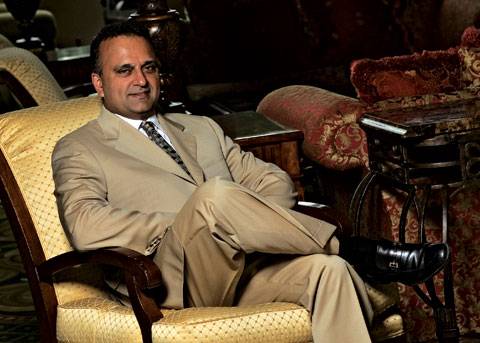“In school, I designed the entire property. I already knew what it was, why it existed, what it’s purpose was.”
Keith Menin left Miami last Thursday night, flew to Milan, got there Friday morning, and had a big event with his whole sales team. They sold 12 apartments. He left Saturday at 4 a.m. and flew to London for two more broker meetings. He went to his friend Craig David’s studio, listened to his new album, saw his concert, had dinner with him, and sold him his tower suite. On Sunday morning, he flew to the Big Apple, and had meetings all Sunday with the Mondrian South Beach’s world-renowned designer, Marcel Wanders. It’s now Monday, and he’s in his tinted black Range Rover, its 22-inch rims whizzing down West Avenue after a meeting with a lender at Joe Allen’s. He races up to the Mondrian and hops out, a tanned young buck in a slick, black Prada shirt and suit, with a coral and gold pocket square. The last words I’m thinking are “family” and “grounded.” Then Menin smiles and says, “Can I get anyone an iced tea or coffee?”
He was a fourth-generation South Beach kid watching how well his uncles, Russ Galbut and Bruce Menin (both managing partners with Crescent Heights, the nation’s premier condominium company), treated people. It must have worked, because he’s just handed his valet guy a bottle of wine. “My uncles taught me that by being nice, and being true, you will succeed in life.”
Wanting to follow in his uncle Russ’ footsteps, he attended Cornell’s esteemed School of Hotel Administration, where he became the president of his class. And before he graduated-early-career day came. “I didn’t go,” he proudly recounts. “I didn’t have a résumé like everybody else; I wasn’t going to work for Lehman Brothers. For me, I like making my family money. People always say, ‘Don’t work with family because it creates problems.’ You know what? They’ve got the wrong family. If you have a family that’s tight and strong and loyal, nothing’s better. I wouldn’t do what I do for anybody else, or do anything else.”
So it’s career day and everybody’s worrying about locking down a $60,000-a-year gig, but Keith Menin was in the zone, already creating his first little masterpiece. “In my last semester, I kept thinking about this one property on Miami Beach, this old-age home off the beaten track,” at 1745 James Avenue. Menin had a complete vision for a boutique condo-hotel concept, which gave him the stones to get to work on The Sanctuary when he was only 21.
“In school, I designed the entire property. I already knew what it was, why it existed, what it’s purpose was,” he says. “The Beach had either the super expensive Delano, or the cheap little boutique Art Deco hotels. I built for the ultra-luxury middle gap.” He asked his uncle for $4 million to get to work on the project. “That $4 million grew to $6 million, then $9 million, and at $10 million, I said to myself, ‘Keith, you can’t fail. If you lose $10 million at 21, how do you ask [your uncles] for another project? You’re done.’ So my fear evolved into this iconic, explosive little hotel that I sold as a condo-hotel for over $1200 a square foot.” It was one of the highest-priced, off-the-water condo-hotels in American history. Keith Menin had knocked his first pitch out of the park.
In his next big at-bat, Menin took his sweet swing to Chicago, where he had never lived. Still, in order to avoid the sophomore slump, he knew he had to comprehend the zeitgeist of the typical Windy City traveler. After spending a full day observing the hustle and bustle at O’Hare, Menin recognized how to customize his approach. The Hotel Rafael, a 110-year-old brick structure in downtown, would be restored as a contemporary old hotel, filling the gap between the traditional Drakes and the trendy Ws. He jazzed up the name to The Raffaelo and dressed the doormen in Ted Baker-black on black, sophisticatedly old world with a modern twist. He centered the lobby on a massive chandelier, offset by candles and eight-foot bouquets of flowers, and with funky music piped in to add to the atmosphere. As he says, “You feel comfortable, yet kind of hip. You’re not at the Marriott or Westin; you feel a little vibe.” The concept worked, Menin had another smash hit, and he triumphantly returned to South Beach, already popping with even bigger ambition.
He found it in the last residential building on West Avenue, fronting Biscayne Bay. “I went to [Morgans Hotel Group] and said, ‘You guys are the kingpins, so I’m not going to waste your time. I have a great, simple deal. I’ll build it. I’ll sell it. You guys design it and operate it. But I want to be your partner.'” At first, everybody thought Menin was crazy for trying to operate a resort off the sands of the beach, but he was able to convince the group to open its first residential venture. “The vision and dream [at the Mondrian South Beach] is amazing. This will be the only building on the Bay where a guy can pull up with his wife on his 60-foot Sunseeker Predator, and get a cabana. His friends will meet him for lunch, they’ll order some bottles, chill out, and swim in the pool. Their wives will go up and get a massage or steam, the guys will go up to the gym, and later, they’ll share a great meal, stay over, get up, and get on the boat refreshed. It’s a total experience.” And Morgans got it. Then the bank got it. So, at 26, Menin had reeled in a new member of the tribe, becoming Morgans’ very first outside partner. Thirty days after their initial meeting, they closed on the $190 million deal, and the Mondrian South Beach was born.
And if you think the familial references are heavy-handed, they’re all Menin’s. It simply cascades out of him like a waterfall, straight from a pure, non-pretentious source. “Partnerships are very, very hard,” he contemplates. “But, with Morgans, we’re one, like a good marriage. [The Mondrian] is like our child. We have to love it and raise it right. We can’t say, ‘Oh, this won’t work out.’ We have to say, ‘How do we teach this child?’ Because it’s not like I’m going to build it and disappear once it’s done and let Morgans run it. And they’re not loaning me the brand and once I sell it, they’re gone.” Both are in it for the long haul.
That’s why, in contrast to a W Hotel that merely licenses a building, there’s an inherent comfort that Morgans, a public company, has 50 percent equity, while Menin, a reputable developer, actually has money and ownership. In fact, he’ll be living in one of the penthouse corner units. “These truths are what make people comfortable,” he crows with a gleam in his eye. “We’re in it together, and it’s what has made this the most exciting and successful projects in the country right now. We opened this place at the beginning of Art Basel 2006, and I’ve sold over 250 of 330 contracts, and closed over 80 deals. I’m on full throttle.”
Which brings up a salient question: Where, when, and how does this connoisseur of the central nervous system, of both the luxury reveler and relaxer, slow down and recharge? True to form, his first response is in yet another project. He’s close to finalizing a deal in Eleuthera, Bahamas, where he’ll recreate The Sanctuary as a private retreat. “And the concept is so cool,” he trumpets. “I’m going to build 50 bungalows around the theme of a couples’ getaway. After a 45-minute flight, a white Range Rover picks you up, and BANG, you’re in another world. You wear a robe or linen all day with a bonfire every night. There’s yoga, there’s tennis, there’s a little restaurant where you have ceviche and they cook a lobster right on the beach for you. My rule may even be: you can’t bring your cell phones. I mean a total retreat, because there’s nowhere so close where you can go like that. That’ll be my little forced relaxation. I need it.”
Stateside, he does find much-needed solace with family. “Twice a week, I leave work at 6 in the afternoon, and drive to Aventura to see my little nephews, Ian and Matthew. I leave my phones in the car and play ball. The love connection we have, it takes me out of everything. When I go to them, it’s like instant, total stress detox.”
I point out how it seems that everything he does is allowing him to be a conduit for an all-important notion of reconnection; reconnecting his nephews with the strong values he was given; reconnecting the dream of South Beach through the Mondrian; and reconnecting by hopping on a jet, connecting more people. The Mondrian building is like a big mansion for an ever-growing, extended family. “That’s what it is,” he confirms. “Jet set is great and fun and exciting, but what’s real is where you started. My family began in one little house on Sheridan Avenue with my dad and aunt and my uncle Bruce and all the kids over one small kitchen table or playing on the floor. So even though my Uncle Bruce now has a massive house in the Hamptons, we’re hanging out. We’re downstairs making pancakes for the kids at 6 in the morning in bathing suits and t-shirts. There’s nothing haughty about it, there’s no B.S. We’re the same family that came from Sheridan.”
Most are lucky if, in an entire lifetime, they learn this. Understand it. And even if they do, during the daily grind, most forget it. But as the 27-year-old whiz kid developer who gets it and I wrap it up and leave the Mondrian, he asks me if I need a ride. I reply, “I’m not going to Aventura.” He grins. He knows that I know that he’s on his way to teach his nephews how to swing for the fences.





















